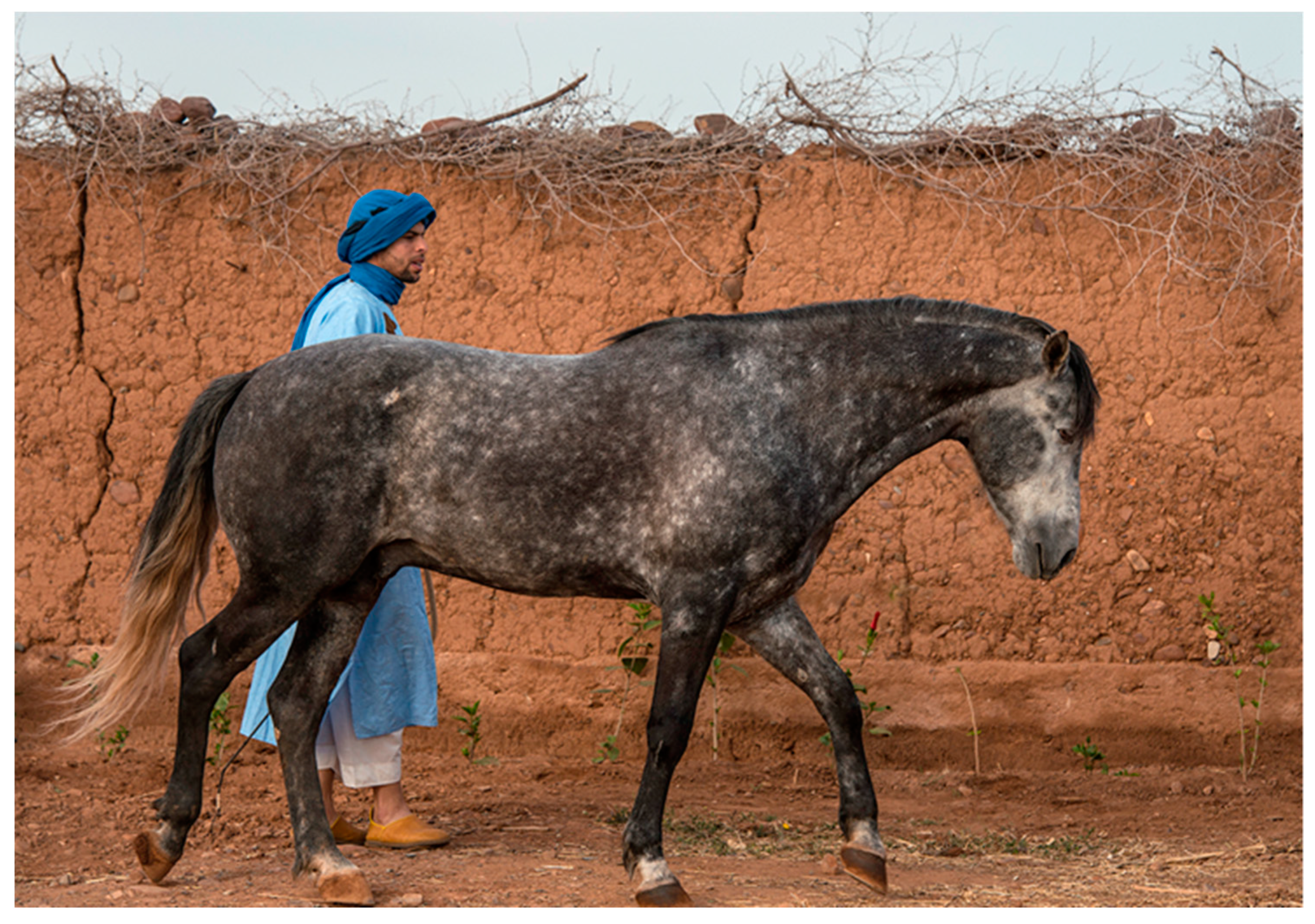Investigation of Cerebellar Abiotrophy (CA), Lavender Foal Syndrome (LFS), and Severe Combined Immunodeficiency (SCID) Variants in a Cohort of Three MENA Region Horse Breeds
Abstract
:1. Introduction
2. Materials and Methods
2.1. Sampling
2.2. DNA Isolation and Genotyping
2.2.1. Cerebellar Abiotrophy (CA)
2.2.2. Severe Combined Immunodeficiency (SCID)
2.2.3. Lavender Foal Syndrome (LFS)
3. Results and Discussion
4. Conclusions
Author Contributions
Funding
Institutional Review Board Statement
Informed Consent Statement
Data Availability Statement
Acknowledgments
Conflicts of Interest
References
- Outram, A.K.; Stear, N.A.; Bendrey, R.; Olsen, S.; Kasparov, A.; Zaibert, V.; Thorpe, N.; Evershed, R.P. The Earliest Horse Harnessing and Milking. Science 2009, 323, 1332–1335. [Google Scholar] [CrossRef] [PubMed]
- Fages, A.; Hanghøj, K.; Khan, N.; Gaunitz, C.; Seguin-Orlando, A.; Leonardi, M.; Constantz, C.M.; Gamba, C.; Al-Rasheid, K.A.; Albizuri, S.; et al. Tracking Five Millennia of Horse Management with Extensive Ancient Genome Time Series. Cell 2019, 177, 1419–1435.e31. [Google Scholar] [CrossRef]
- Orlando, L. Ancient Genomes Reveal Unexpected Horse Domestication and Management Dynamics. BioEssays 2019, 42, 1900164. [Google Scholar] [CrossRef] [PubMed] [Green Version]
- Shev, E.T. The Introduction of the Domesticated Horse in Southwest Asia. Archaeol. Ethnol. Anthropol. Eurasia 2016, 44, 123–136. [Google Scholar] [CrossRef] [Green Version]
- Felkel, S.; Vogl, C.; Rigler, D.; Dobretsberger, V.; Chowdhary, B.P.; Distl, O.; Fries, R.; Jagannathan, V.; Janečka, J.E.; Leeb, T.; et al. The horse Y chromosome as an informative marker for tracing sire lines. Sci. Rep. 2019, 9, 6095. [Google Scholar] [CrossRef]
- Cosgrove, E.J.; Sadeghi, R.; Schlamp, F.; Holl, H.M.; Moradi-Shahrbabak, M.; Miraei-Ashtiani, S.R.; Abdalla, S.; Shykind, B.; Troedsson, M.; Stefaniuk-Szmukier, M.; et al. Genome Diversity and the Origin of the Arabian Horse. Sci. Rep. 2020, 10, 9702. [Google Scholar] [CrossRef]
- Mebarki, M.; Kaidi, R.; Benhenia, K. Morphometric description of Algerian Arab-Barb horse. Revue Méd. Vét. 2018, 169, 7–9, 185–190. [Google Scholar]
- Sisó, S.; Hanzlíček, D.; Fluehmann, G.; Kathmann, I.; Tomek, A.; Papa, V.; Vandevelde, M. Neurodegenerative diseases in domestic animals: A comparative review. Vet. J. 2006, 171, 20–38. [Google Scholar] [CrossRef] [PubMed]
- De Lahunta, A. Abiotrophy in domestic animals: A review. Can. J. Vet. Res. 1990, 54, 65–76. [Google Scholar] [PubMed]
- Blanco, A.; Moyano, R.; Vivo, J.; Flores-Acuna, R.; Molina, A.; Blanco, C.; Monterde, J.G. Purkinje Cell Apoptosis in Arabian Horses with Cerebellar Abiotrophy. J. Vet. Med. Ser. A 2006, 53, 286–287. [Google Scholar] [CrossRef]
- Brault, L.S.; Penedo, M.C.T. The frequency of the equine cerebellar abiotrophy mutation in non-Arabian horse breeds. Equine Veter- J. 2011, 43, 727–731. [Google Scholar] [CrossRef] [PubMed]
- Brault, L.S.; Famula, T.R.; Penedo, M.C.T. Inheritance of cerebellar abiotrophy in Arabians. Am. J. Vet. Res. 2011, 72, 940–944. [Google Scholar] [CrossRef] [PubMed]
- Bugno-Poniewierska, M.; Stefaniuk-Szmukier, M.; Piestrzyńska-Kajtoch, A.; Fornal, A.; Piórkowska, K.; Ropka-Molik, K. Genetic screening for cerebellar abiotrophy, severe combined immunodeficiency and lavender foal syndrome in Arabian horses in Poland. Vet. J. 2019, 248, 71–73. [Google Scholar] [CrossRef]
- Brooks, S.A.; Gabreski, N.; Miller, N.; Brisbin, A.; Brown, H.E.; Streeter, C.; Mezey, J.; Cook, D.; Antczak, U.F. Whole-Genome SNP Association in the Horse: Identification of a Deletion in Myosin Va Responsible for Lavender Foal Syndrome. PLoS Genet. 2010, 6, e1000909. [Google Scholar] [CrossRef] [PubMed] [Green Version]
- Alkalamawy, N.; Amin, D.; Alkalamawy, I.; Elaty, I.A. Lavender foal syndrome in Egyptian Arabian horses: Molecular and pathological studies. SVU-Int. J. Vet. Sci. 2018, 1, 55–65. [Google Scholar] [CrossRef]
- Tarr, C.J.; Thompson, P.N.; Guthrie, A.J.; Harper, C.K. The carrier prevalence of severe combined immunodeficiency, lavender foal syndrome and cerebellar abiotrophy in Arabian horses in South Africa. Equine Vet. J. 2014, 46, 512–514. [Google Scholar] [CrossRef] [PubMed] [Green Version]
- Efendić, M.; Maćešić, N.; Samardžija, M.; Vojta, A.; Korabi, N.; Capak, H.; Sušnić, M.A.; Žaja, I.; Pećin, M.; Babić, N.P. Determination of Sublethal Mutation Causing Lavender Foal Syndrome in Arabian Horses From Croatia. J. Equine Vet. Sci. 2018, 61, 72–75. [Google Scholar] [CrossRef]
- McGuire, T.C.; Poppie, M.J. Hypogammaglobulinemia and thymic hypoplasia in horses: A primary combined immunodeficiency disorder. Infect Immun. 1973, 8, 272–277. [Google Scholar] [CrossRef] [Green Version]
- Ela, N.A.A.; El-Nesr, K.A.; Ahmed, H.; Brooks, S.A. Molecular Detection of Severe Combined Immunodeficiency Disorder in Arabian Horses in Egypt. J. Equine Vet. Sci. 2018, 68, 55–58. [Google Scholar] [CrossRef]
- Shin, E.K.; Perryman, L.E.; Meek, K. Evaluation of a test for identification of Arabian horses heterozygous for the severe combined immunodeficiency trait. J. Am. Vet. Med Assoc. 1997, 211, 1268–1270. [Google Scholar]
- Shin, E.K.; Perryman, L.E.; Meek, K. A kinase-negative mutation of DNA-PK(CS) in equine SCID results in defective coding and signal joint formation. J. Immunol. 1997, 158, 3565–3569. [Google Scholar] [PubMed]
- Piro, M.; Benjouad, A.; Tligui, N.S.; El Allali, K.; El Kohen, M.; Nabich, A.; Ouragh, L. Frequency of the severe combined immunodeficiency disease gene among horses in Morocco. Equine Vet. J. 2008, 40, 590–591. [Google Scholar] [CrossRef] [PubMed]
- Kul, B.Ç.; Ağaoğlu, Ö.K.; Ertugrul, O.; Durmaz, M. Investigation of severe combined immunodeficiency (SCID) disease of Arabian horses raised at the state stud farms in Turkey. Ank. Üniversitesi Vet. Fakültesi Derg. 2014, 61, 59–63. [Google Scholar] [CrossRef]



| Gene | Primers | Method Used for Genotyping |
|---|---|---|
| TOE1 | F: GGATCTCAACCCTCCTCTCC R: CGTGTGTCATGCTGCCAGGAaCC | PCR-ACRS |
| PRKDC | F: GGTAGCTTTGTGTTCCTGTTG R: TTCTCTCATTGCCAGAAGCA | Sanger sequencing |
| MYO5A | F: CAGAGCCTGAAGGAGGAGAA R: GTCAGCCGGGTGATCTCAT | Sanger sequencing |
| Genotypes (N/%) | Alleles | ||||
|---|---|---|---|---|---|
| Breed | CC | CT | TT | C | T |
| Barb | 41 | - | - | 1 | |
| 100% | |||||
| Arab Barb | 56 | - | - | 1 | |
| 100% | |||||
| Arabian | 75 | 5 | - | 0.94 | 0.06 |
| 93.7% | 6.3% | ||||
| Total | 172 | 5 | - | 0.99 | 0.01 |
| 97.2% | 2.8% | ||||
| Genotypes (N/%) | Alleles | ||||
|---|---|---|---|---|---|
| Breed | WT/WT | WT/SCID | SCID/SCID | WT | SCID |
| Barb | 41 | - | - | 1 | |
| 100% | |||||
| Arab Barb | 55 | 1 | - | 0.99 | 0.01 |
| 98.2% | 1.3% | ||||
| Arabian | 71 | 9 | - | 0.94 | 0.06 |
| 88.7% | 11.3% | ||||
| Total | 167 | 10 | - | 0.97 | 0.03 |
| 94.3% | 5.7% | ||||
Publisher’s Note: MDPI stays neutral with regard to jurisdictional claims in published maps and institutional affiliations. |
© 2021 by the authors. Licensee MDPI, Basel, Switzerland. This article is an open access article distributed under the terms and conditions of the Creative Commons Attribution (CC BY) license (https://creativecommons.org/licenses/by/4.0/).
Share and Cite
Ayad, A.; Almarzook, S.; Besseboua, O.; Aissanou, S.; Piórkowska, K.; Musiał, A.D.; Stefaniuk-Szmukier, M.; Ropka-Molik, K. Investigation of Cerebellar Abiotrophy (CA), Lavender Foal Syndrome (LFS), and Severe Combined Immunodeficiency (SCID) Variants in a Cohort of Three MENA Region Horse Breeds. Genes 2021, 12, 1893. https://doi.org/10.3390/genes12121893
Ayad A, Almarzook S, Besseboua O, Aissanou S, Piórkowska K, Musiał AD, Stefaniuk-Szmukier M, Ropka-Molik K. Investigation of Cerebellar Abiotrophy (CA), Lavender Foal Syndrome (LFS), and Severe Combined Immunodeficiency (SCID) Variants in a Cohort of Three MENA Region Horse Breeds. Genes. 2021; 12(12):1893. https://doi.org/10.3390/genes12121893
Chicago/Turabian StyleAyad, Abdelhanine, Saria Almarzook, Omar Besseboua, Sofiane Aissanou, Katarzyna Piórkowska, Adrianna D. Musiał, Monika Stefaniuk-Szmukier, and Katarzyna Ropka-Molik. 2021. "Investigation of Cerebellar Abiotrophy (CA), Lavender Foal Syndrome (LFS), and Severe Combined Immunodeficiency (SCID) Variants in a Cohort of Three MENA Region Horse Breeds" Genes 12, no. 12: 1893. https://doi.org/10.3390/genes12121893
APA StyleAyad, A., Almarzook, S., Besseboua, O., Aissanou, S., Piórkowska, K., Musiał, A. D., Stefaniuk-Szmukier, M., & Ropka-Molik, K. (2021). Investigation of Cerebellar Abiotrophy (CA), Lavender Foal Syndrome (LFS), and Severe Combined Immunodeficiency (SCID) Variants in a Cohort of Three MENA Region Horse Breeds. Genes, 12(12), 1893. https://doi.org/10.3390/genes12121893







